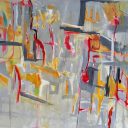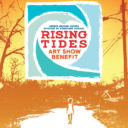The exhibition of Tommy Crow’s photographs of Cuba at Seaside Assembly Hall on February 21 represented more than the display of artistic talent applied to a magical place that is no longer frozen in time. The event also marked the first discussions of an emerging art movement along Scenic Highway 30A, burgeoning from the New Urbanist design movement that began in 1981.
With the advent of Seaside as an urban alternative to typical tourism and residential development, there has been an unprecedented flowering of architecture and interior design; and subsequently of art, film, literature, and the performing arts in our area since Seaside’s inception in 1981. Crow is among those New Urbanist artists whose work may coalesce a specific coastal art movement.
After attending the University of Georgia, Crow began his professional career in advertising, becoming a premier American photographer in the field. He arrived on Scenic Highway 30A in 2004, and hosted a series of gatherings mobilizing support for the local arts. He opened Tommy Crow Studios in Rosemary Beach and Alys Beach, in 2010 and 2015, respectively.
The Seaside Institute is dedicated to fostering cultural activities within the scenic corridor that spans from Watercolor, to Rosemary Beach and Alys Beach, as well as serving as a national platform for education in New Urbanism. Associated with Tommy’s show was a discussion with Andrès Duany on the imminent challenges and prospects of an authentic, non-commercial culture along Scenic Highway 30A.
Duany, a native Cuban and the town planner for Seaside, Rosemary Beach, and Alys Beach explained that he views our southern beaches as Caribbean —as opposed to the Gulf Coast. Duany explained, “The Gulf Coast reference exposes a bias for the North American point of view—those who actually inhabit the Caribbean think of your coast as the northern edge of the Caribbean sea. It is thus that.” In Duany’s estimation, Key West, Seaside, New Orleans, and Galveston share more with Havana, Cartagena and Aruba than they do with the continental United States.
“The architects of Seaside who were so influenced by Key West and New Orleans; the architects of Rosemary who were so influenced by the Anglo-Caribbean of Kingston; and then there is the influence of San Juan, Cartagena, and Antigua on Alys Beach. This shows that the art of architecture grasped the Caribbean early and deeply – they have been able to developed rich regional tradition of architecture based on the Caribbean,” Duany continues.“Tommy’s artistic instincts were to drench himself in Havana, as similar to that of Richard Sexton, a long-time photographer and resident of Seaside who has published a book interspersing Havana and New Orleans. Crow unconsciously tapped into the roots and the foundation of the new urbansim.”
Beverly Walters, Chairwoman for The Seaside Institute hopes that the that the many artists who are drawn to these New Urbanist communities, will coalesce as thoroughly as the architects have in consciously nurturing a regional art movement. “It’s a new era….”





